Could there be such a thing as fashion in the Warsaw Uprising? Were there any trends in clothing? It's time to check how the girls dress up for the "W" hour. And were they really "in barricade dresses".
On the morning of August 1, 1944, underground soldiers began to concentrate. Everyone was walking silently to their assembly place and only Warsaw cyclists noticed that the clothes of young people were not completely ordinary. Of course, the future insurgents were not to pay unnecessary attention to themselves, so as not to prematurely alert the Germans. Some differences were necessary though.
The boys tried to take care of clothes that would allow them to easily crawl or jump over fences (strong and comfortable shoes, solid pants and shirts). Their friends were in a much worse situation. Girls parading around the streets of occupied Warsaw in such clothes would immediately attract unwanted glances. How is that! Girl in pants ?! It is not appropriate!
For an uprising as for a picnic!
As a result, those that were to treat the wounded under fire, went to the uprising dressed as for a walk by the Vistula River . Nurse Halina Jędrzejewska (pseudonym "Sławka") mentions in the pages of the book "Girls from the Uprising":
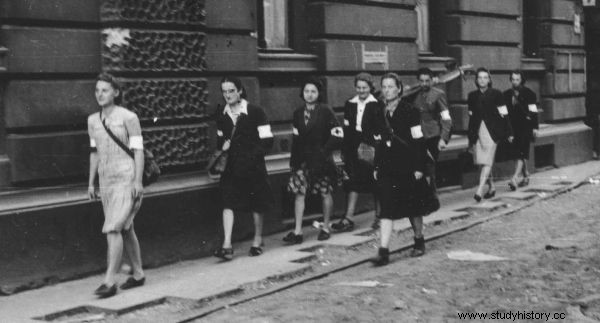
Dresses, skirts, blouses with a white collar and an armband. The photo shows the departure of the sanitary patrol of the Home Army Military Service for Women at 9 Moniuszki Street, August 5, 1944.
We believed we could chase the Germans out quickly. Following the instructions for the Uprising, we left prepared for two days of combat. I was in a summer dress and a sanitary bag over my shoulder.
Elsewhere, "Sławka" describes exactly his outfit. She herself had comfortable shoes (which must have turned out to be beneficial during the fights) and a thin dress. Many of her friends took great care of themselves just before the "W" hour. They looked beautiful, although they dressed completely impractical for such an "occasion". Anyway, who could have known then, under what conditions would young Varsovians be beaten?
I went to the Uprising in a dress from a scout uniform that was left somewhere else. A thin dress - this is gray linen, nothing more. I didn't have any sweater, nothing, it's good that I had shoes on my legs, I don't remember which ones anymore, but I had comfortable slippers in which I could walk . But the older friends came in very different clothes, sometimes in very nice clothes, but completely inappropriate for that time (quoted after:Archive of Oral History of the National Museum in Warsaw, testimony by Halina Jędrzejewska).
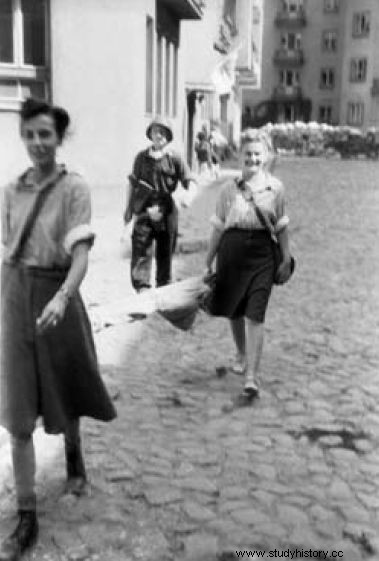
Even in the case of the greatest fashionista, clothing was relegated to the background. The mission was important. The photo shows a nurse with a stretcher.
Another girl fighting in the uprising, Zofia Radecka, describes the outfit in which she went into battle:
I was completely unprepared for the fact that the Uprising would last more than two or three days. Apart from changing my underwear, I didn't have any clothes with me. And I was wearing a striped dress and leather sandals. Dress for a picnic, not for a fight (quoted after:AHM, testimony of Zofia Radecka).
Girls rushing under fire in those summer dresses and light shoes differed from civilians only by insurgent armbands. This is also remembered by the actress, Alina Janowska, who served as a messenger during the uprising: armbands on the sleeve - it was our only »uniform« (quoted after:D. Michalski, "I am Alina, or Janowska Story").
A panther like a dream
When the branch of Halina Jędrzejewska acquired the Tobacco Monopoly at ul. Dzielna Street, it was raining. Although the action was a success, the woman does not remember her well. The insurgents were completely soaked. When they had to spend the night on the stone steps of a captured factory, girls were in a particularly bad situation.
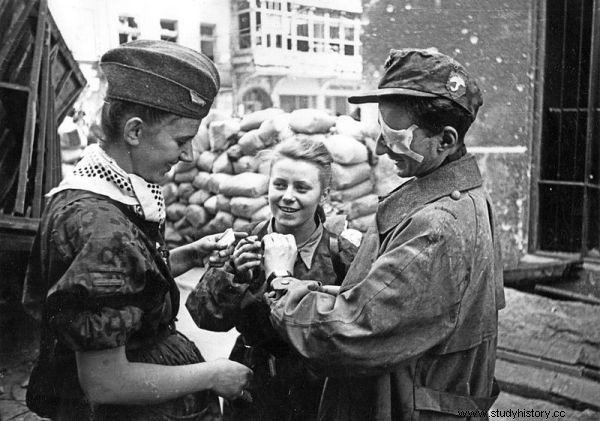
Nurses in famous leopards and a wounded insurgent from the "Parasol" battalion.
In summer dresses, unable to change clothes or cover themselves with anything, they shivered with cold all night, sitting and sleeping on the stairs. Any jacket, coat or warm sweater seemed to be a dream for them at the time.
Another soldier, Janina Kolasińska (aka "Żaba"), wrote directly:
I was assigned to [Zofia] Bratkowska, WSK commander. So I was her liaison and ran all the sewers, not the sewers, through those double, joint, sewer pipes. There were holes dug underground and it crawled. There were no uniforms, I was wearing a dress. I don't remember wearing pants at all. And then through dark streets ... (quoted after:AHM, Janina Kolasińska's testimony).
Some of the fighting girls got their supplies right at the beginning of the fight, after capturing German military warehouses in Stawki. As "Sławka" recalls, the insurgents found a lot of German uniforms there. This is where the following came from:, among others, the famous leopards, which were later used by the entire Uprising (quoted after:A. Herbich, "Girls from the Uprising") .
After acquiring the magazines, Halina Jędrzejewska finally put together a decent and comfortable outfit for herself. She was given a leopard print and uniform pants, and from her colleagues in the squad, a men's shirt found in an abandoned apartment.
A kingdom for a washing machine and "something on your tits"
Problems with clothing, especially underwear, only increased with the prolonged insurrection. After running water was cut off in the capital, it was not possible to freely wash and dry clothes. Danuta Stępniewska (aka "Niusia") recalls how difficult it was for the girls fighting in the uprising to refresh their clothes:
There was nothing to say about any wash, because it was hard with water and it was difficult to stay naked when you were wearing one dress. It is possible that "Ziuta" gave me a sweater, but I don't remember it anymore. These were the things that took a back seat. (quoted after:AHM, testimony of Danuta Stępniewska)
Considering the fact that many of the insurgents left the house prepared for two days of fighting, and the uprising lasted as many as sixty-three, it was necessary to deal with it. Mostly just looking for another piece of clothing somewhere.
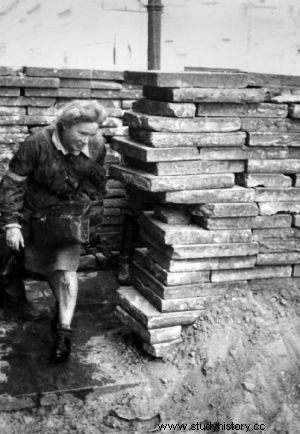
Although the insurgents traveled through sewers full of dirt, there was no question of any washing. The photo shows a liaison officer leaving the sewers on Nowy Świat.
With underwear, especially typical women's underwear, the situation was a bit worse. While the lack of stockings was not a special problem for the soldiers, without a bra, with freely bouncing breasts, it was hard to run and crawl.
A related funny story from the memories of "Sławka" is quoted by the author of the book "Girls from the Uprising", Anna Herbich:
Once, it was on Książęca Street, a colleague from the branch approached me. He was smiling broadly, he was just bursting with pride.
- "Sławka", I have something for you - he said.
- What?
- Look, I got you something on your tits! - At that moment he stretched out the hand in which he had a bra. I remember that his friends almost choked him then.
The nurses 'colleagues, instilled from an early age, spoke to the nurses' colleagues. They couldn't imagine talking to a woman like that!

The article was inspired by the book by Anna Herbich "Girls from the Uprising" (Znak Horyzont 2014).
Obsztorcały boyfriend what the world stands for (in their opinion) a shameful insult to his friend. She herself did not feel offended at all. Quite the opposite! She was very grateful. As she recalled years later: did me a really great service. I finally had a bra!
Clothes? A momentary thing!
Hardly acquired clothing, uniform, could be lost at any moment. More than once it was necessary to navigate through sewers full of impurities, or to treat the wounded with blood and pus, and then the clothes smelled so bad that it was a pain to continue wearing it. Besides, it was enough that the nurse or the messenger was in the wrong place and time.
If a high-caliber projectile or other explosive exploded at close range, a blast was created and shrapnel was flying in all directions. When a German tank trap exploded on Kilińskiego Street, Teresa Potulicka (aka "Michalska") experienced such a moment of terror.
I fell over, covered in blood and bits of guts. The shockwave ripped my skirt open, all clothes were hanging on me in tatters . But then I didn't even notice it. I was in shock, my ears were ringing. (quoted after:A. Herbich, "Girls from the Uprising").
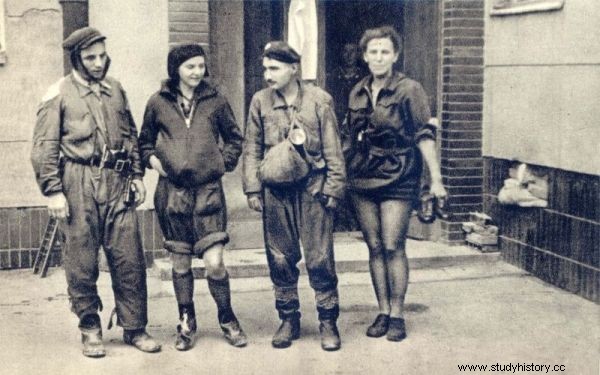
If the insurgents had such an opportunity, they adjusted their clothes to the circumstances. The photo shows four sewer guides on the Śródmieście-Mokotów section. Ladies in short pants. It would be difficult for them to wade in the sewers in a different outfit.
When female soldiers lost their skirts or dresses, their colleagues from the unit saved them from this oppression of clothes. Halina Wołłowicz (aka "Rena") recalled:
The skirt I went to the Uprising was no longer good for anything. Already during the retreat I received some pants from Wieśk Fidler "Grot", which - it was raining, we were struggling through the swamps - stiffened to such an extent that my thighs were damaged to blood. Even so, I tried to hold on somehow and not cry. This was our first day of fighting (quoted after:A. Herbich, "Girls from the Uprising").
Were the girls fighting in the Warsaw Uprising dressed in any fashion? Dress, booties and slightly curled hair were not something obvious. Each of the fighters was trying to get dressed somehow, so as not to freeze at night on watch, after all, the closer to the end of the fighting, the colder the nights became. Halina Jędrzejewska (aka "Sławka") briefly and bluntly summarized the issue of the insurgent dress code: It was not a fashion, we didn't have anything (quoted after:AHM, Halina Jędrzejewska's testimony).
Sources:
Basic:
- A. Herbich, Girls from the Uprising , Znak Horyzont, Warsaw 2014.
Complementary:
- Archive of Oral History of the National Museum in Warsaw, testimony of Halina Jędrzejewska [access:May 25, 2014].
- Archive of Oral History of the National Museum in Warsaw, testimony by Janina Kolasińska [access:May 25, 2014].
- Archive of Oral History of the National Museum in Warsaw, testimony by Zofia Radecka [access:May 25, 2014].
- Archive of Oral History of the National Museum in Warsaw, testimony by Danuta Stępniewska [access:25/05/2014].
- D. Michalski, I am Alina, or Janowska Story , Warsaw 2007.
